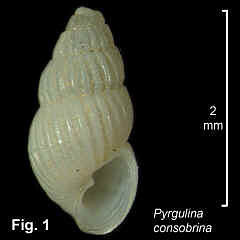|
|
PYRAMIDELLIDAE |
|
|
|
Pyrgulina consobrina (A. Adams, 1861) Description: Shell medium size, relatively wide, spire weakly convex, up to 5 teleoconch whorls. Protoconch. infolded, type C. Teleoconch whorls rounded, suture well defined, sculptured with strong axial folds, extending onto the base on last whorl; spiral sculpture of fine threads between axials on upper third of spire whorls, with a single, thin spiral cord at lower third. On last whorl, spiral cord persists on periphery and dense spirals threads are present between axials on base. Aperture length 1½ times width, columella with strong plait. Shell colourless-transparent becoming opaque white with age. Size: Up to 3.2 mm in length Distribution: Indo-West Pacific. In eastern Australia, from Torres Strait southwards to Sydney. Habitat: In NSW, empty shells are known from beach washup and from dredgings down to 15 m. Common. Comparison: Compared to Pyrgulina caelatura, this species has a type C protoconch rather than type B. In P. caelatura the fine spirals in interspaces between axials are uniformly spread over the whorl from suture to suture, but in C. consobrina they are more prominent at the bottom third of the whorls, and are particularly noticeable on the last whorl. The single thin spiral cord at the lower third of spire whorls, that continues at the periphery of last whorl, is another distinguishing character. Synonymy: Synonyms which have been previously recognised in the NSW literature are Chrysallida pseudalveata Nomura, 1936, Elodiamea ora Laseron, 1959, and Pyrgulina spissa Laseron, 1959. Fig. 1: Bare Island, Botany Bay, NSW, at 10 m depth (C.340812). |
|
